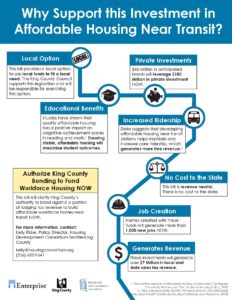Housing & Transportation
 Why Support Investment in Affordable Housing Near Transit?
Why Support Investment in Affordable Housing Near Transit?
Affordable housing and transit make our communities livable for people of all incomes. Click the image to enlarge.
For an easy-to-print PDF version, click here.
TransForm, California Housing Partnership Corporation, 2014
In 2014, the Center for Neighborhood Technology analyzed households in California to define five types based on income and access to public transportation. Two critical findings emerged:
- Lower income families drive 25-30% less when living within a half-mile of transit and up to 50% less when living a quarter-mile away.
- Higher income families drive more than twice as much as extremely low-income families living within the quarter-mile range of public transit and own more than twice as many vehicles.
Where does affordable housing fit into all this? The report also linked greenhouse gas reduction to affordable housing through a cap-and-trade investment. By using 10% of cap-and-trade auction earnings for a Transit-Oriented Development (TOD) Housing program, 15,000 new affordable homes can be created over a three-year period, according to the study. The authors estimate that this program would prevent 105 million miles worth of driving – annually. As a result, greenhouse gasses would be cut by more than 1.58 million metric tons over the lifespan of the new affordable housing units. In other words, economic and environmental justice are linked. This proposal highlights ways the affordable housing coalition can be broadened by building stronger, more accessible communities and a brighter environmental future.
Transportation Emerges as Crucial to Escaping Poverty
The New York Times, Mikayla Bourchard, May 7, 2015
Based on: “The Impacts of Neighborhoods on Intergenerational Mobility,” Raj Chetty and Nathaniel Hendren, Harvard University, April 2015
Affordable housing and transportation are invariably linked. As evidence, a New York Times article by Mikayla Bourchard discusses how poor transportation infrastructure (public and otherwise) perpetuates poverty. Bourchard cites a Harvard Study which states that access to reliable transportations is the “strongest factor in the odds of escaping poverty.” According to the researchers, the more time a commute takes, the more difficult it is for lower income families to transcend social classes. Bourchard also references a report from NYU’s Rudin Center for Transportation that discovered that areas with some, but insufficient, access to transportation — had the highest rates of unemployment and the lowest incomes.”
Both of these findings illuminate the need for more reliable and affordable forms of transportation. There is a complicating factor in the housing-transportation connection: In order to raise the social mobility of their children, families have moved farther from their jobs in order to live in a safer neighborhood with better schools. However, the same lack of reliable transportation is a limiting factor. Constructing affordable housing without access to nearby dependable transit ultimately limits access to economic opportunity, thus, preventing lower-income families from emerging from the cycle of poverty.
High Housing Costs Mean Long Commutes in Boston Area
How Housing Matters, Jan. 2015
Based on research from: ULI Terwilliger Center for Housing, National Housing Conference, Center for Neighborhood Technology
A report from the Urban Land Institute suggests that when discussing housing affordability, transportation costs must also be considered. In major cities, housing and transportation costs account for a large portion of personal or family budgets. High costs associated with urban living force citizens to find more affordable housing outside city limits, which then increases their transportation costs and greenhouse gas emissions.
In the Boston area, approximately 54% of a family’s income goes towards housing and transportation, leaving a much smaller budget to pay for other necessities. In the surrounding suburban areas, low housing costs translate into high transportation costs, negating the cheaper housing and lengthening commute times. This same pattern could be applied to other major U.S. cities.
The report also points out that affordable housing is critical in propelling the economy, but transportation access is a hindering factor. City growth without improvements in housing affordability or transit infrastructure prevents the local economy from reaching its potential. It is no surprise that the report also links transportation to environmental impacts. High-density neighborhoods located near economic opportunity reduces vehicle miles by 25-30%, effectively reducing harmful emissions. Access to affordable housing and transportation are inextricably linked to reducing economic and environmental stress in America’s cities.


